 There's a mural that runs through the center of Hanoi, installed on the old dyke created to hold back the waters of the Red River when it floods.
There's a mural that runs through the center of Hanoi, installed on the old dyke created to hold back the waters of the Red River when it floods. The Red River is the place where Emperor Ly saw the golden dragon rising from the water, and so made Ha Noi (“Ascending Dragon”) his capital. The dyke is believed to be about 900 years old,
The Red River is the place where Emperor Ly saw the golden dragon rising from the water, and so made Ha Noi (“Ascending Dragon”) his capital. The dyke is believed to be about 900 years old,  and has always protected the town from floods. The dyke was covered in concrete in 1990, making this old structure more permanent; as a 900 year old levee or dyke, it truly is one of the oldest
and has always protected the town from floods. The dyke was covered in concrete in 1990, making this old structure more permanent; as a 900 year old levee or dyke, it truly is one of the oldest  structures in the city, and a witness to the city’s history and development. The dyke is sort of in two parts, the larger part facing the road with the middle full of plants, and then a
structures in the city, and a witness to the city’s history and development. The dyke is sort of in two parts, the larger part facing the road with the middle full of plants, and then a  taller wall in back of the plants. The mural is on both the lower and upper walls, with the plants inbetween. You can see this in some of the photos.
taller wall in back of the plants. The mural is on both the lower and upper walls, with the plants inbetween. You can see this in some of the photos.In 2007, the New Hanoi
 Arts organization received permission to implement the Hanoi Ceramic Mural Project, bringing together visual artists, sculptors, ceramicists, artisans, designers, architects, and volunteers to
Arts organization received permission to implement the Hanoi Ceramic Mural Project, bringing together visual artists, sculptors, ceramicists, artisans, designers, architects, and volunteers to  beautify the city by creating the mural on the dyke.
beautify the city by creating the mural on the dyke.Now, it gets a little confusing with the names. In Vietnam, the family name goes first,
 then the individual’s given name (and maybe a middle name). Plus there are some extremely common last names, so that the
then the individual’s given name (and maybe a middle name). Plus there are some extremely common last names, so that the  primary players in this project seem to all be related, having the same last name. (They may be related, for all I know!)
primary players in this project seem to all be related, having the same last name. (They may be related, for all I know!)Anyway, the project manager/director is Mr. Nguyen Huy Cuong; the project founder is Ms.
 Nguyen Thu Thuy; and Ms. Nguyen Thuy Van is Vice Director of the New Hanoi Arts Ltd. They all have experience in visual arts as well as
Nguyen Thu Thuy; and Ms. Nguyen Thuy Van is Vice Director of the New Hanoi Arts Ltd. They all have experience in visual arts as well as  journalism, so they’ve been able to generate publicity (and maybe funds) as well as coordinate this huge project. The two supervising artists are Mr. Bui Viet Doan and
journalism, so they’ve been able to generate publicity (and maybe funds) as well as coordinate this huge project. The two supervising artists are Mr. Bui Viet Doan and  Mr. Ha Huy Hiep.
Mr. Ha Huy Hiep. So when I say a HUGE project, I do mean huge. The mural is four kilometers long. Yes, that’s right, 4 km. Equal to about 2.5 miles of mosaic mural. It truly
 goes on and on and on, documenting the history and
culture and people of Vietnam. Amazing!!!! I’ve only completed two
murals that are 9 meters long and 3 meters high - and while this mural
is
goes on and on and on, documenting the history and
culture and people of Vietnam. Amazing!!!! I’ve only completed two
murals that are 9 meters long and 3 meters high - and while this mural
is  between 1-2 meters tall (3-6 ft), it is what, over 200 times longer.
Makes me tired just thinking about how much work it took to create this
incredible work of art!
between 1-2 meters tall (3-6 ft), it is what, over 200 times longer.
Makes me tired just thinking about how much work it took to create this
incredible work of art! Like me, Ms. Thuy travelled in countries where mosaics are part of the history as well as the modern culture (Italy, Spain, Greece, to name a few), and she too fell in love with
Like me, Ms. Thuy travelled in countries where mosaics are part of the history as well as the modern culture (Italy, Spain, Greece, to name a few), and she too fell in love with  ceramic mosaics. She already knew about the gorgeous ceramics of Vietnam, an art form that stretch back at least two millennia. So she put together a
ceramic mosaics. She already knew about the gorgeous ceramics of Vietnam, an art form that stretch back at least two millennia. So she put together a  presentation where she photoshopped images on the ugly concrete dyke, talked to the local government about this idea, and the project was born. (We all know it wasn’t that quick and simple, but that’s the
presentation where she photoshopped images on the ugly concrete dyke, talked to the local government about this idea, and the project was born. (We all know it wasn’t that quick and simple, but that’s the  short summary.)
short summary.) The concept was

 approved in 2007, with the thought to complete the mural by 2010, the
approved in 2007, with the thought to complete the mural by 2010, the  1000th anniversary of the city of Ha Noi. Quite ambitious, the design and create 4 km of mosaic mural in only 3 years! The funds were
1000th anniversary of the city of Ha Noi. Quite ambitious, the design and create 4 km of mosaic mural in only 3 years! The funds were  raised by “social contributions” (I’m guessing businesses donated funds and supplies, as well as
raised by “social contributions” (I’m guessing businesses donated funds and supplies, as well as 
 individuals - the only one listed in the information I found was
individuals - the only one listed in the information I found was  the Ford Foundation, so contributions came from local and international sources), artists and volunteers were recruited, and work began. Not only was this going to become
the Ford Foundation, so contributions came from local and international sources), artists and volunteers were recruited, and work began. Not only was this going to become  the longest mural of its kind in the world, this mosaic would be one of the first pieces of public art in Vietnam. Other than political posters and sculpture rendered in the “Socialist realism”
the longest mural of its kind in the world, this mosaic would be one of the first pieces of public art in Vietnam. Other than political posters and sculpture rendered in the “Socialist realism”  style, there really is very little public art in this country.
style, there really is very little public art in this country.The artists’ designs featured a broad view of the history and culture of Vietnam. There are
 river and sea scenes, images of temples and pagodas, traditional towns, modern cities, farms, and thatched huts. There are people at work, riding bicycles along the street, playing
river and sea scenes, images of temples and pagodas, traditional towns, modern cities, farms, and thatched huts. There are people at work, riding bicycles along the street, playing  musical instruments, dancing, farming. There’s an image of Buddha, a many-armed Hindu god, and Emperor Ly. Dragons, cats, dogs, the occasional water buffalo are all
musical instruments, dancing, farming. There’s an image of Buddha, a many-armed Hindu god, and Emperor Ly. Dragons, cats, dogs, the occasional water buffalo are all  included. The history of ceramics is featured in one section, with both bas-relief workers making clay products as well as flattened images of ginger jars, tea pots, bowls, and such.
included. The history of ceramics is featured in one section, with both bas-relief workers making clay products as well as flattened images of ginger jars, tea pots, bowls, and such.  Another section is obviously children’s art - various schools became
Another section is obviously children’s art - various schools became 
 involved by
involved by  having students submit their
having students submit their  drawings, which were then rendered in ceramic tile by the
drawings, which were then rendered in ceramic tile by the  artists.
artists. It was interesting to see the various styles used in the mural. Some artists created scenes in the Champa style, showing the influences
 of Hindu art that arrived in Vietnam. Others used a traditional Asian, almost Japanese style. Still others created trees and suns reminiscent of van Gogh’s “Starry Night,” swirls of color.
of Hindu art that arrived in Vietnam. Others used a traditional Asian, almost Japanese style. Still others created trees and suns reminiscent of van Gogh’s “Starry Night,” swirls of color.  And of course, everyday scenes of Vietnam show Vietnamese people, created in the traditional ceramic styles of Vietnam.
And of course, everyday scenes of Vietnam show Vietnamese people, created in the traditional ceramic styles of Vietnam.Traditional arts are also portrayed in mosaic -
 there are women weaving ikat patterns,
there are women weaving ikat patterns, 
 embroidering in the Hmong style, and they are surrounded by
embroidering in the Hmong style, and they are surrounded by  waving ribbons of these designs. Five elements flags wave in the ceramic breeze, carp kites fly.
waving ribbons of these designs. Five elements flags wave in the ceramic breeze, carp kites fly.And since the mural is beside the river, on the
 dyke that protects the city from flooding, there are boats, junks, floating
dyke that protects the city from flooding, there are boats, junks, floating 
 markets, fish and fishermen, shore birds, and bridges. Often featured is the Long
markets, fish and fishermen, shore birds, and bridges. Often featured is the Long  Bien bridge, which we can see from our hotel’s breakfast room and restaurant. This 1.5 km bridge (just over 2 miles long) was designed by
Bien bridge, which we can see from our hotel’s breakfast room and restaurant. This 1.5 km bridge (just over 2 miles long) was designed by  Monsieur Eiffel and company. Just one more Eiffel bridge in Vietnam, now memorialized in ceramic tile.
Monsieur Eiffel and company. Just one more Eiffel bridge in Vietnam, now memorialized in ceramic tile.One of the websites I found about the mural had this additional
 information:
information:“Over 20 Vietnamese, 15 foreign artists, 100 craftsmen and 500 children collaborated on the project. The foreign
 contingent included embassies and culture centers in Hanoi such as the Goethe-Institut, L’espace and the British Council.
contingent included embassies and culture centers in Hanoi such as the Goethe-Institut, L’espace and the British Council.“The mural itself was
 made using ceramic tesserae, a type of tile used in mosaic which are a product of the Bat Trang village. It is organized into 21 sections and portrays the different decorating styles throughout the
made using ceramic tesserae, a type of tile used in mosaic which are a product of the Bat Trang village. It is organized into 21 sections and portrays the different decorating styles throughout the  history of Vietnam. Indeed many have considered the mural to be a visual narrative of the country’s history.
history of Vietnam. Indeed many have considered the mural to be a visual narrative of the country’s history.“In October 2010, the
 Hanoi Mosaic Mural was awarded a Guinness World Records certificate for the world’s largest ceramic mosaic, with a length of around 4 KM. Ms. Thuy was proud of the
Hanoi Mosaic Mural was awarded a Guinness World Records certificate for the world’s largest ceramic mosaic, with a length of around 4 KM. Ms. Thuy was proud of the  achievement and stated that the project “reflects the vibrancy and complexity of Vietnam’s capital city, and is the ideal way to commemorate Hanoi’s 1,000 year anniversary.”
achievement and stated that the project “reflects the vibrancy and complexity of Vietnam’s capital city, and is the ideal way to commemorate Hanoi’s 1,000 year anniversary.” “It is safe to say that the completion of the Mosaic Mural was a beautiful way to celebrate the millennial anniversary of Hanoi.”
“It is safe to say that the completion of the Mosaic Mural was a beautiful way to celebrate the millennial anniversary of Hanoi.” Okay for those of you who are still with me, you stalwart readers and art fanatics like me - the mural is amazing! I walked down our little street and crossed the insane traffic of the
Okay for those of you who are still with me, you stalwart readers and art fanatics like me - the mural is amazing! I walked down our little street and crossed the insane traffic of the  multi-lane main highway-like road that runs by the mural, sort of like playing dodge ball with scooters, cars, buses, and trucks. I think this was just about mid-mural, and then I
multi-lane main highway-like road that runs by the mural, sort of like playing dodge ball with scooters, cars, buses, and trucks. I think this was just about mid-mural, and then I  walked south along the mosaic, a bit over a mile to the end. I didn’t take photos of everything, although it looks like it in this blog. (This is maybe half of my photos - and I only took photos
walked south along the mosaic, a bit over a mile to the end. I didn’t take photos of everything, although it looks like it in this blog. (This is maybe half of my photos - and I only took photos  of the best parts.) But it truly was incredible and beautiful and inspiring and, for anyone who has done any mural or mosaic work, overwhelmingly wonderful to see this collaborative piece of
of the best parts.) But it truly was incredible and beautiful and inspiring and, for anyone who has done any mural or mosaic work, overwhelmingly wonderful to see this collaborative piece of  art.
art.Just a few funny stories - I brought along a bag of peanut M&Ms in my pocket, since I wasn’t sure how far the mural stretched nor how long
 I’d be out. It was a grey and misty day, though not cold, and traffic was busy. Certain images I could get, standing on the sidewalk, but sometimes the image would extend higher
I’d be out. It was a grey and misty day, though not cold, and traffic was busy. Certain images I could get, standing on the sidewalk, but sometimes the image would extend higher  above the dyke, with an extra bit of wall added to support the tile. So I’d have to wait for a lull in traffic to step out into the road and snap my photos. Most of the drivers on scooters
above the dyke, with an extra bit of wall added to support the tile. So I’d have to wait for a lull in traffic to step out into the road and snap my photos. Most of the drivers on scooters  would pull around and smile, happy to see a traveller appreciating this major piece of Ha Noi art. A few honked their horn, saying hello or “get outta my way!” But one man drove by looking absolutely
would pull around and smile, happy to see a traveller appreciating this major piece of Ha Noi art. A few honked their horn, saying hello or “get outta my way!” But one man drove by looking absolutely  befuddled, as if I were completely insane. I just smiled at him as he drove by, staring at me with the most appalled look on his face.
befuddled, as if I were completely insane. I just smiled at him as he drove by, staring at me with the most appalled look on his face. One older (ancient) gentleman was obviously outside for exercise, just pacing back and forth along maybe one city block of road. The first few times he passed me, he
One older (ancient) gentleman was obviously outside for exercise, just pacing back and forth along maybe one city block of road. The first few times he passed me, he  ignored me. After a while, he’d give me a little nod. By the time I was moving on to the next block, we were old buddies and I was rewarded with a smile from him.
ignored me. After a while, he’d give me a little nod. By the time I was moving on to the next block, we were old buddies and I was rewarded with a smile from him. But my favorite - I walked up to the Buddha image, and took a few photos. Then, in the tradition of this country, I placed a little offering at the base of the statue. Okay, so it
But my favorite - I walked up to the Buddha image, and took a few photos. Then, in the tradition of this country, I placed a little offering at the base of the statue. Okay, so it  was just a few M&Ms, but that was all I had and it seemed appropriate. (Like leaving a little offering at a Greek temple, or pouring a drizzle of wine at the ground at a
was just a few M&Ms, but that was all I had and it seemed appropriate. (Like leaving a little offering at a Greek temple, or pouring a drizzle of wine at the ground at a  picnic. Doesn’t everyone do that?) Then I came to the Hindu god or goddess, and left a few more M&Ms. Well, I came to the image of Emperor Ly, and I figured he’s an
picnic. Doesn’t everyone do that?) Then I came to the Hindu god or goddess, and left a few more M&Ms. Well, I came to the image of Emperor Ly, and I figured he’s an  ancestor for Ha Noi, so he needed a little offering as well, right? So I placed an M&M or two at his feet. At this point, another older (but not ancient) man, cheerier guy, walked by
ancestor for Ha Noi, so he needed a little offering as well, right? So I placed an M&M or two at his feet. At this point, another older (but not ancient) man, cheerier guy, walked by  and saw me doing this. He smiled, sort of smacked my shoulder in a friendly way, said something in Vietnamese while waving his hand around, and started walking on.
and saw me doing this. He smiled, sort of smacked my shoulder in a friendly way, said something in Vietnamese while waving his hand around, and started walking on.  I replied that I was just leaving an offering for the ancestors, I wasn’t littering. (I have no clue if he was berating me or applauding what I was doing.) Anyway, we both walked on. I
I replied that I was just leaving an offering for the ancestors, I wasn’t littering. (I have no clue if he was berating me or applauding what I was doing.) Anyway, we both walked on. I  reached the end of the mural, turned around, walked back, and eventually passed the same friendly guy - at this point, he gives me a giant smile and nod, so I guess he was approving
reached the end of the mural, turned around, walked back, and eventually passed the same friendly guy - at this point, he gives me a giant smile and nod, so I guess he was approving  of my leaving an offering, even if it was only a brightly colored M&M or two.
of my leaving an offering, even if it was only a brightly colored M&M or two.Anyway, it was a fabulous way to spend our last full day in Vietnam. I’ve been
 planning to walk along the mural ever since I saw it from our windows, and we drove by the north part of it on the way to the airport when we flew to Hong Kong. I’d love to walk
planning to walk along the mural ever since I saw it from our windows, and we drove by the north part of it on the way to the airport when we flew to Hong Kong. I’d love to walk  the entire length, but half will have to do, especially in the chilly grey weather we’ve been having here in northern Vietnam.
the entire length, but half will have to do, especially in the chilly grey weather we’ve been having here in northern Vietnam. I’m including a few websites for anyone who wants more information about the mural. And while a few people on tripadvisor thought it wasn’t a big deal, they obviously have never created a
I’m including a few websites for anyone who wants more information about the mural. And while a few people on tripadvisor thought it wasn’t a big deal, they obviously have never created a  mosaic mural, nor are they art lovers. For anyone who enjoys art, has made a mural, or just appreciates the wondrous things humans can do as a group, go on out and
mosaic mural, nor are they art lovers. For anyone who enjoys art, has made a mural, or just appreciates the wondrous things humans can do as a group, go on out and  walk along a length of this mural. It really is wonderful, and a testament to the human spirit.
walk along a length of this mural. It really is wonderful, and a testament to the human spirit.(Note: photo spacing may be weird - I did my best!)


 http://hanoimural.blogspot.com/
http://hanoimural.blogspot.com/http://www.mosaicmarble.com/blog/the-hanoi-ceramic-mosaic-mural-worlds-largest-ceramic-mosaic/
http://www.travelfish.org/sight_profile/vietnam/hanoi_and_surrounds/hanoi/hanoi/2439
https://redravine.wordpress.com/2010/10/25/worlds-largest-ceramic-mosaic-hanois-ceramic-mosaic-mural-project/
http://en.wikipedia.org/wiki/Hanoi_Ceramic_Mosaic_Mural














































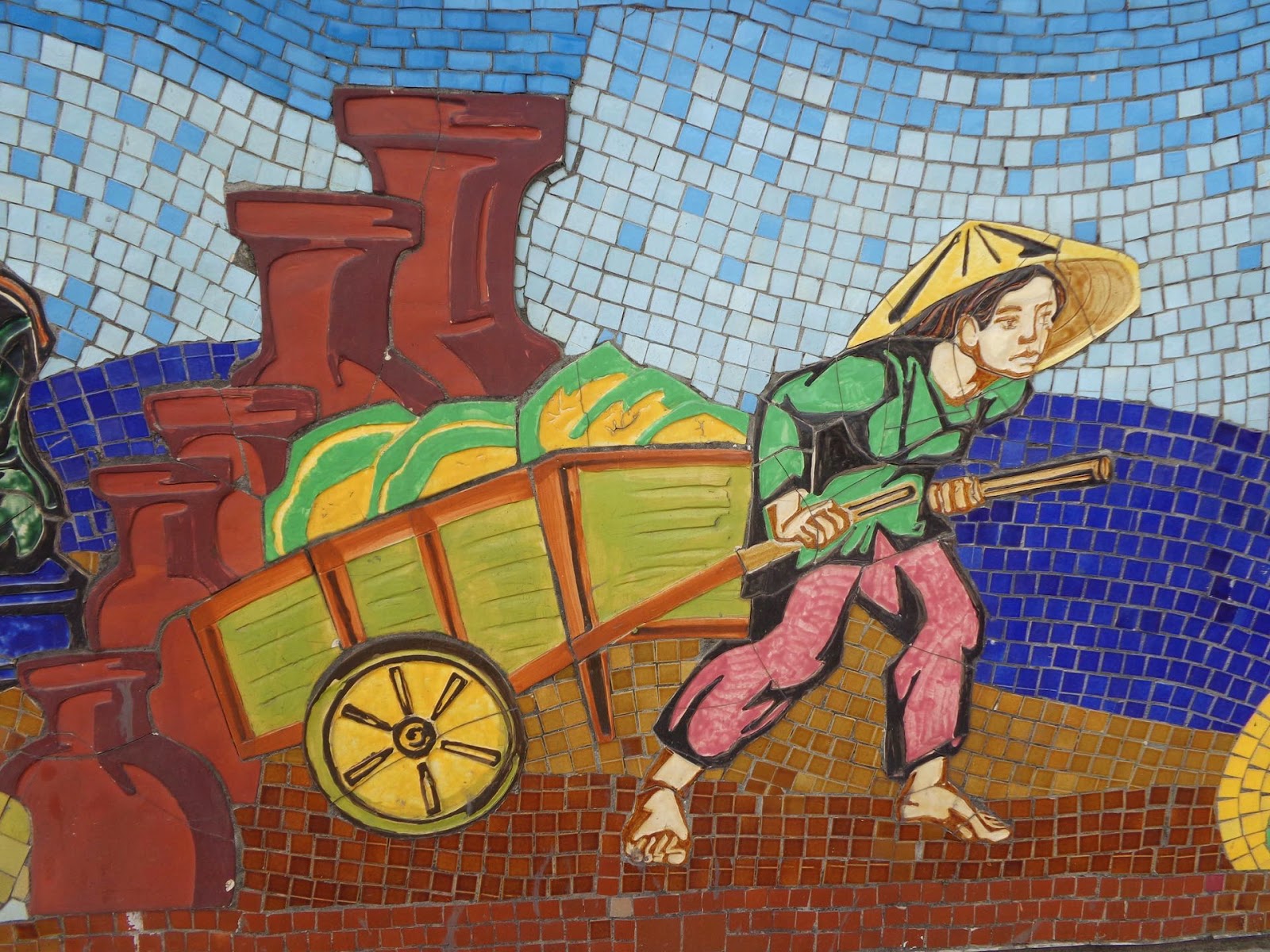
























































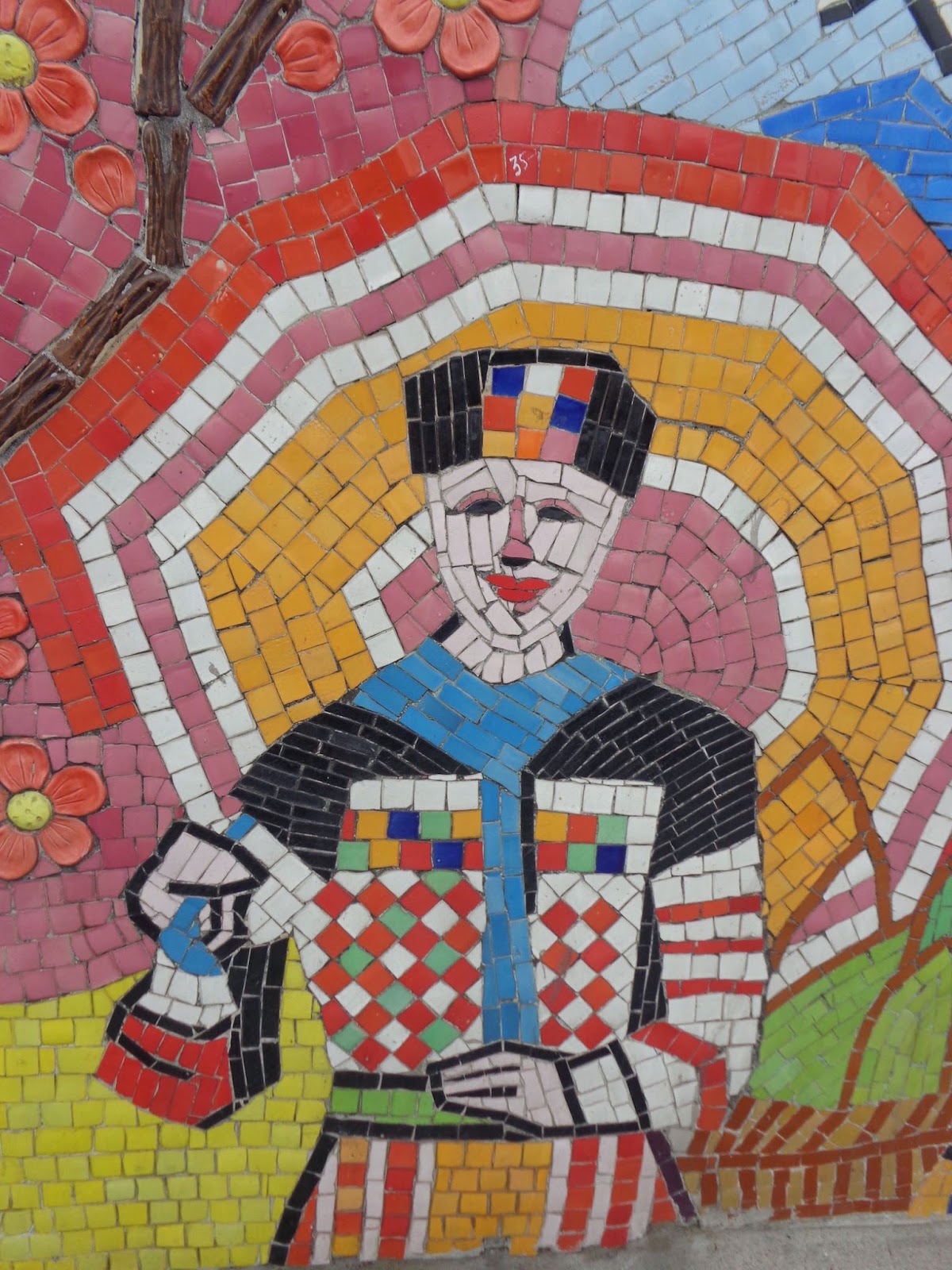
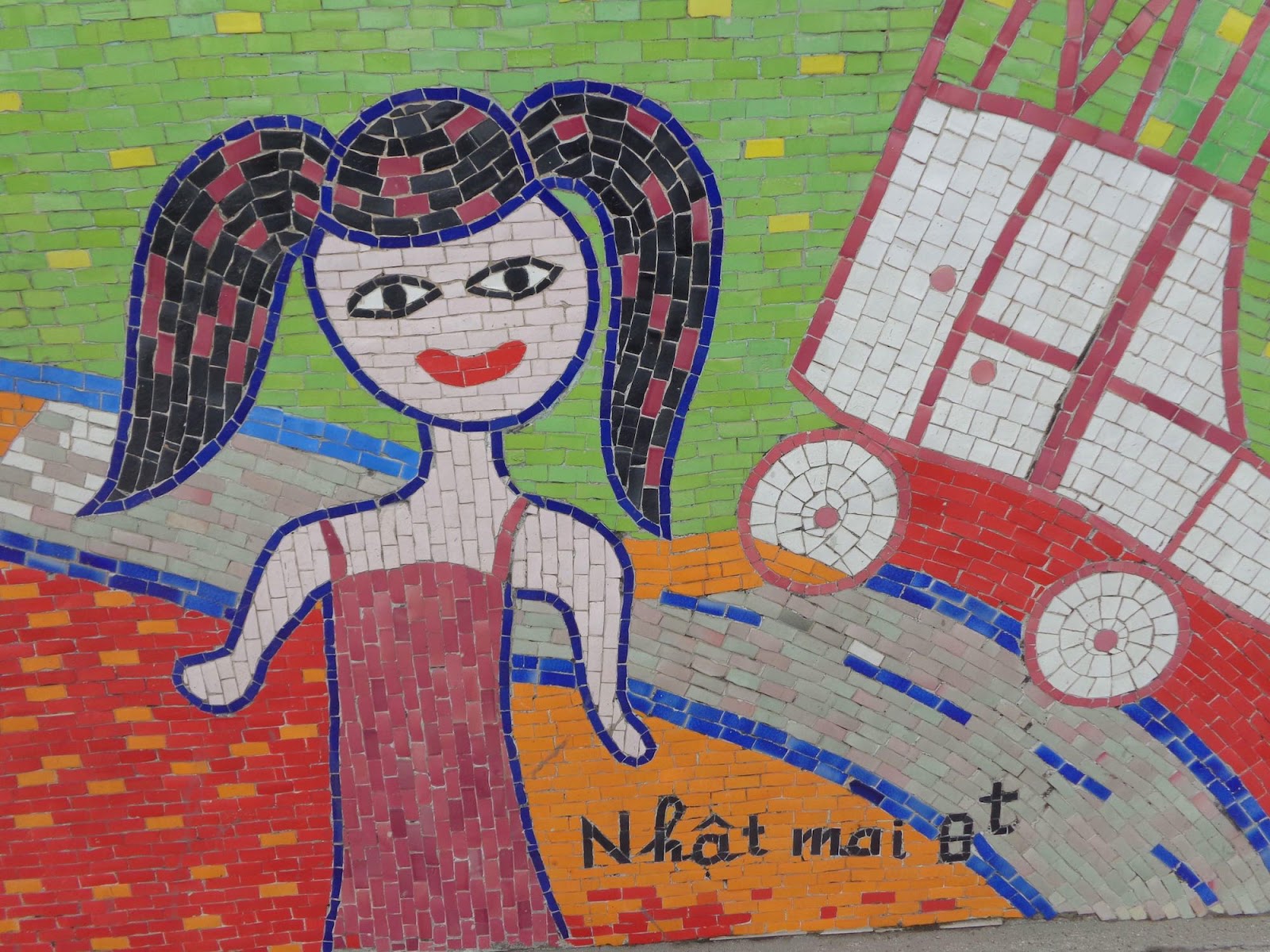




















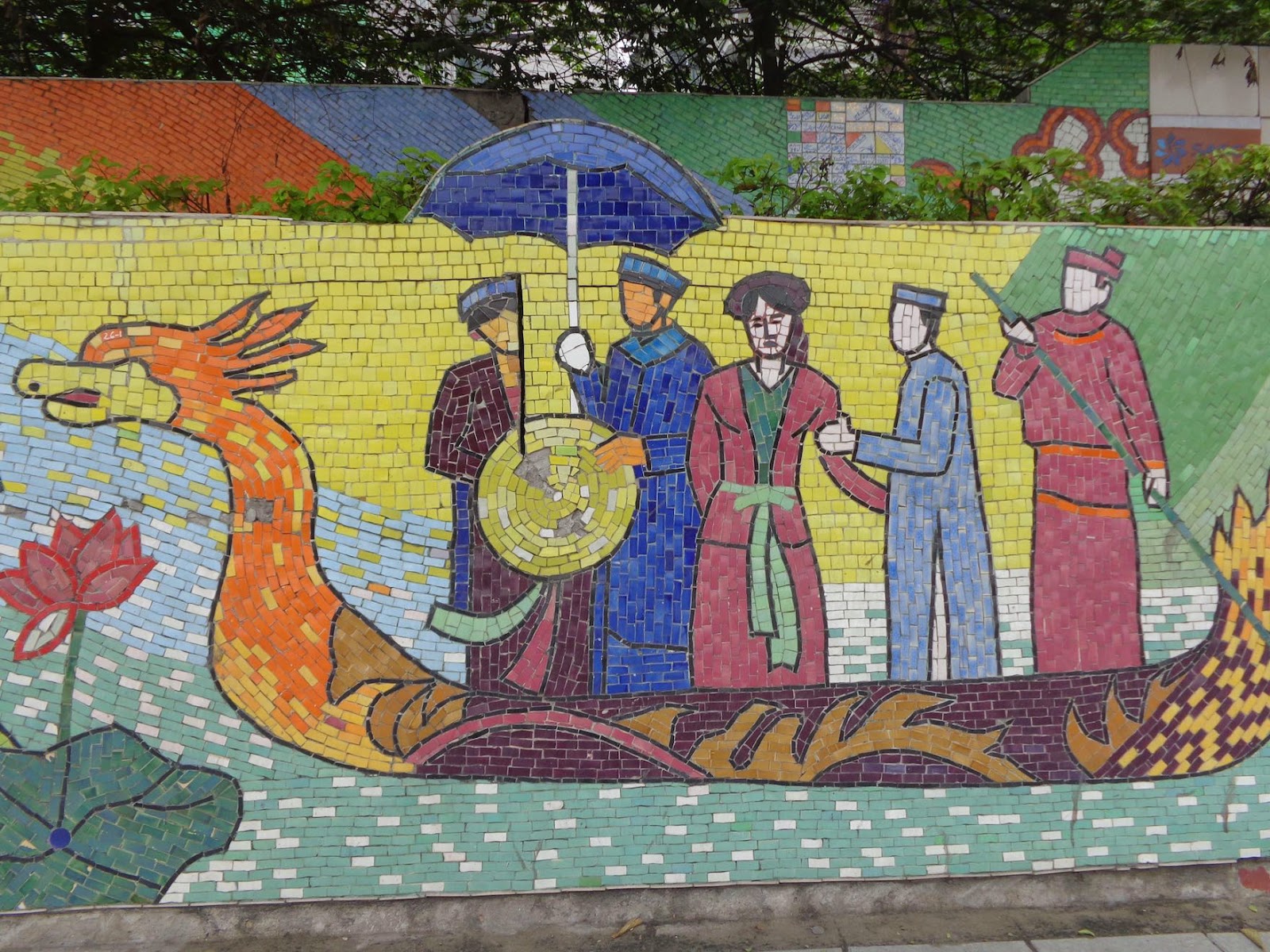



















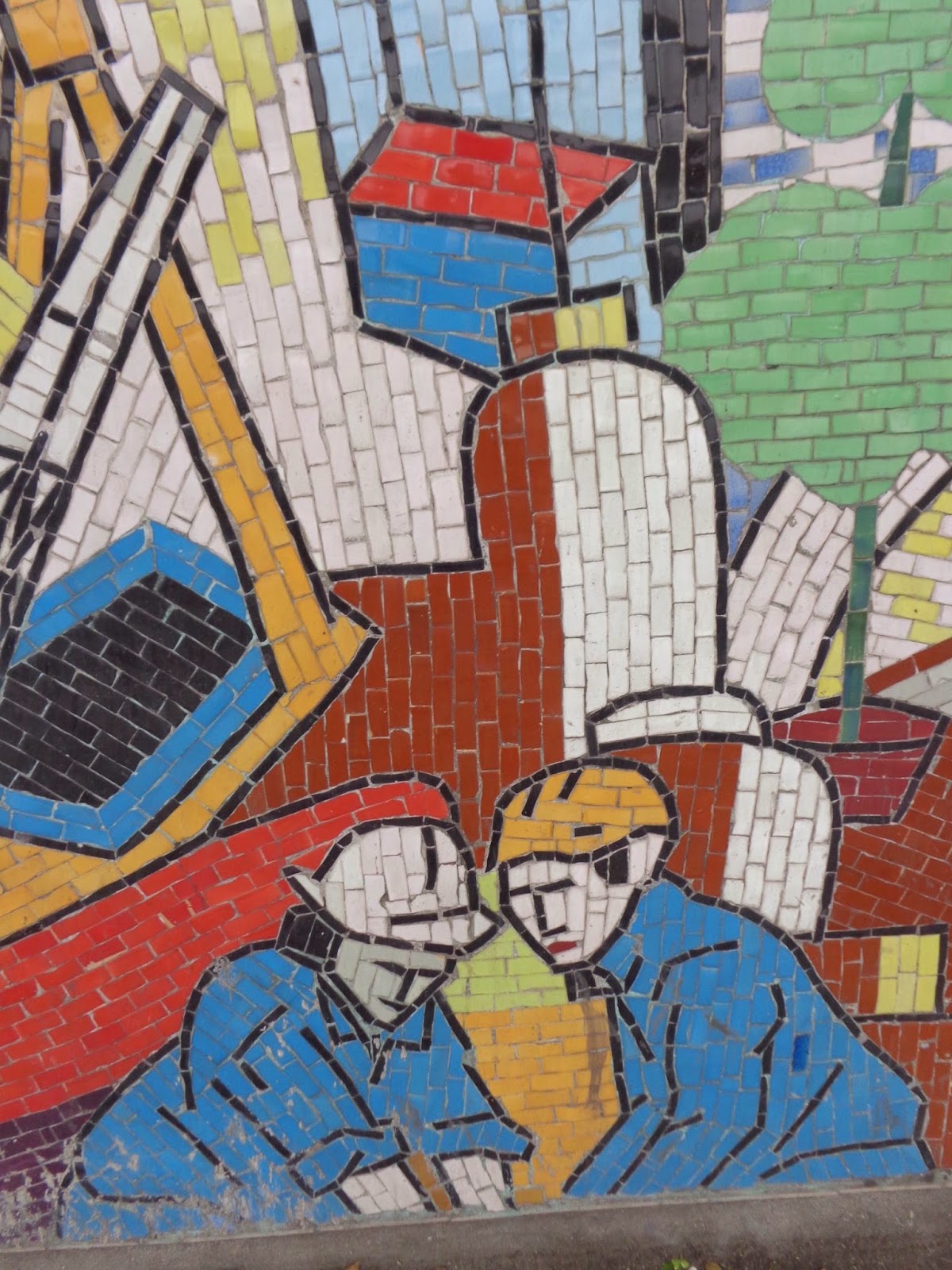









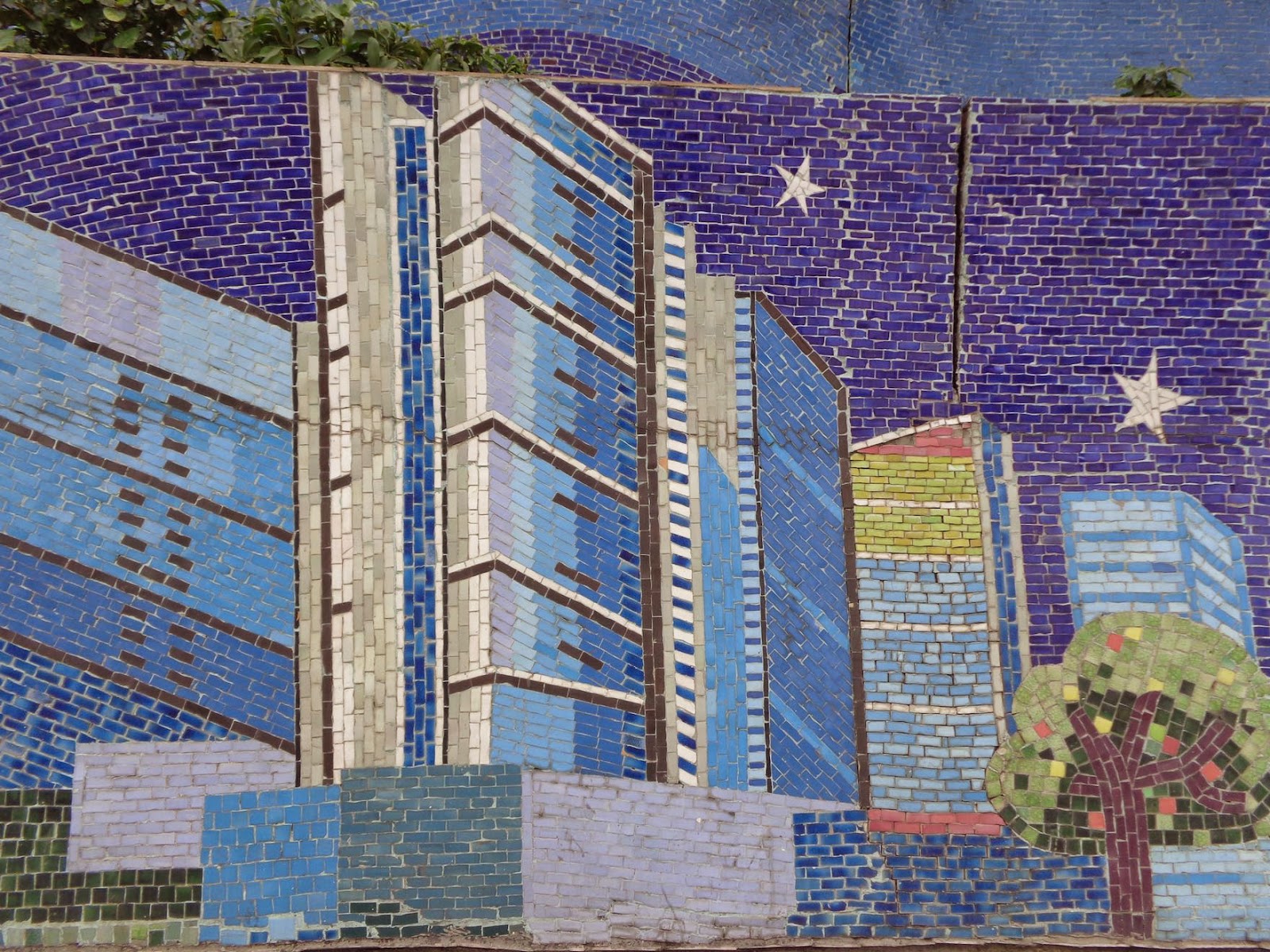












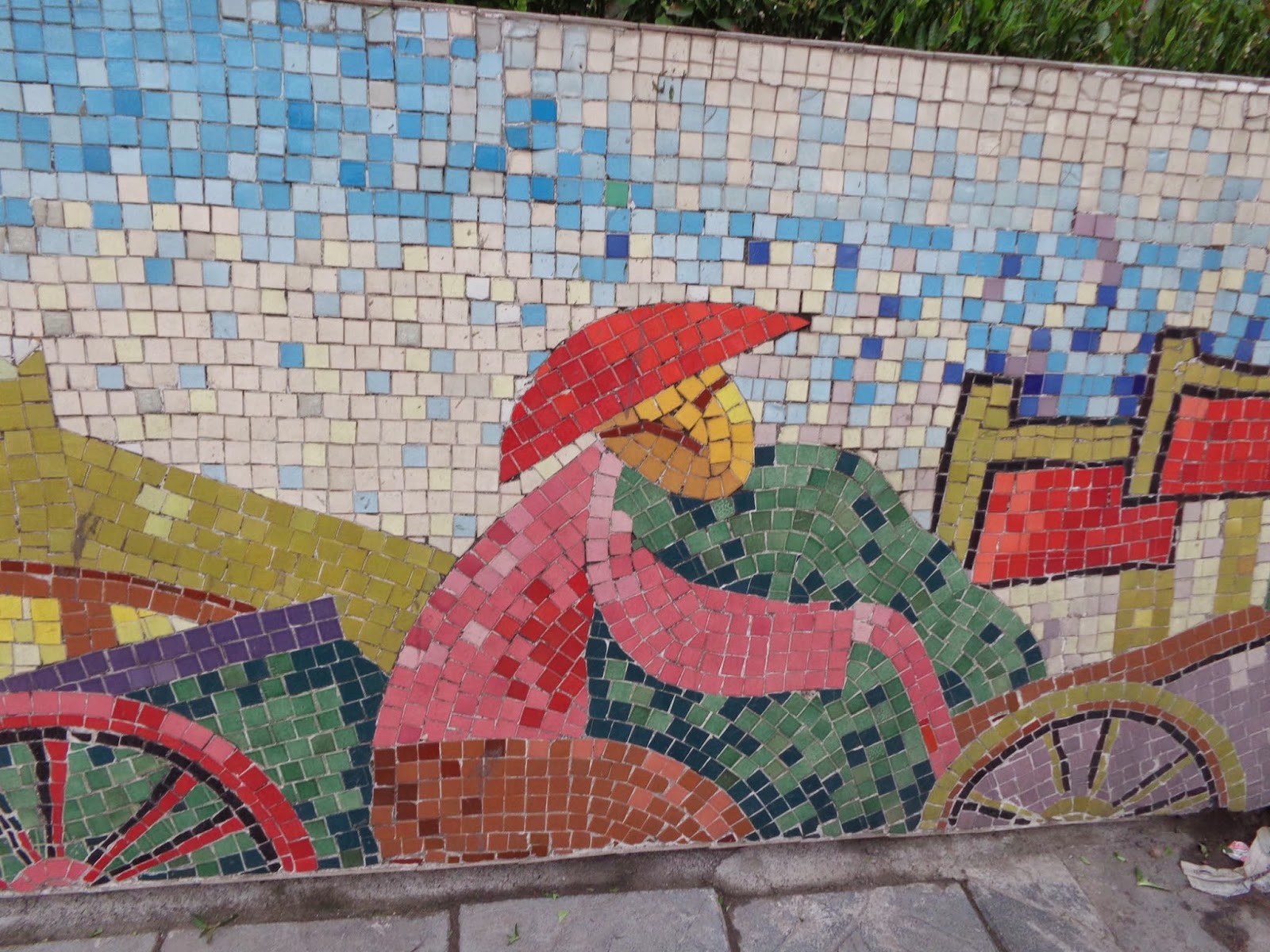

Amazing! Thank you so much for the tour! xoxox
ReplyDeleteI just wish I had done this a few days earlier, so I could have walked in the other direction and seen all of it!!!!
ReplyDelete